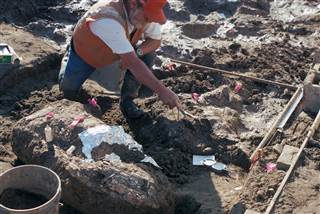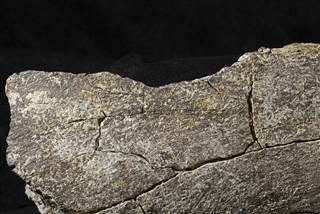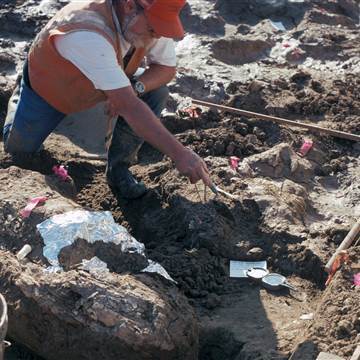Paleontologists have dug up a 130,000-year-old mastodon skeleton that looks like it was smashed apart by humans. But they found it in America, where people were not supposed to have arrived for another 100,000 years.
How could that have happened?
The researchers say they think early humans must have come to America much, much earlier than anyone ever thought. They suggest that other scientists start looking for evidence of people in places they never bothered looking before.


If the conclusions are confirmed, they will turn North American archaeology upside down.
“I know people will be skeptical of this because it is so surprising and I was skeptical when I first looked at the material itself. But it’s definitely an archaeological site,” said Steven Holen of the Center for American Paleolithic Research in South Dakota.
The site includes a skeleton that looks like it was taken apart and broken with stone tools, which are left in place alongside the bones they smashed. One tusk appears to have been stuck upright into the ground.
“It appears to be impossible that a mastodon could somehow force its own tusk into the underlying deposits,” the research team noted in their report, published in the journal Nature.
Related: DNA Links Ancient Americans to their Living Descendants
The only reasonable explanation, they say, is that humans did it.
Uranium dating puts the site at around 130,000 years old.
“My first reaction on reading this paper was ‘No. This is wrong. Something’s wrong,'” said stone tool expert John McNabb of the University of Southampton in Britain.
“If it does turn out to be true, it changes absolutely everything.”


Current wisdom holds that modern humans arrived in the Americas no earlier than about 15,000 years ago. The oldest widely accepted site for the first Americans dates to just 13,000 years ago.
The main theory is that people crossed a land bridge across the Bering Strait between modern-day Alaska and Siberia during the last Ice Age, when sea levels were lower, and then migrated down the west coast.
Related: DNA Points to Prehistoric Hanky-Panky
Some other researchers have challenged this idea, but their findings are hotly disputed.
If the San Diego finding holds up, it likely means that Homo erectus, Neanderthals or a related early human species, the Denisovans, crossed much, much earlier. They could have crossed on foot during a previous Ice Age much earlier than 130,000 years ago, the researchers say, or come by boat.
“My first reaction on reading this paper was ‘No. This is wrong. Something’s wrong.’”
It’s slightly possible that modern humans made the crossing, the researchers say. But no human remains were found at the site, so it’s impossible to say who butchered the mastodon.
“This discovery is rewriting our understanding of when humans reached the New World,” Judy Gradwohl, president and CEO of the San Diego Natural History Museum, said in a statement.
The site was first found in 1992 when road crews were putting up a sound berm — a wall of dirt to quiet traffic noise — along State Route 54 near San Diego. Paleontologists carefully excavated the mastodon skeleton, along with large, oddly-shaped rocks and the bones of other extinct animals such as dire wolf, horse, camel, mammoth and ground sloth.
They also got a good estimate of how old the site is.
What’s now a busy road was a stream bed 130,000 years ago, the researchers said. “It was a meandering stream close to sea level,” Thomas Deméré of the San Diego Natural History Museum told reporters in a conference call.
“It was a very nice place to live, I would think, 130,000 years ago — not far from the coastline.”
Related: 400,000-Year-Old Human DNA Adds to Tangled Knowledge
The smash patterns on the mastodon bones and the stones left nearby look as if humans used the stones as tools to break apart bone to use for more tools, and perhaps to get at the nutritious bone marrow inside the large leg bones, the research team said.
Strangely, it does not look like they cut meat off the bones — something that gives pause to experts like McNabb.
“This discovery is rewriting our understanding of when humans reached the New World.”
Most of the site was preserved under many feet of dirt and the Natural History Museum team carefully excavated and examined it by hand, documenting where each piece was and saving samples of dirt and rock alongside the bones and big stones.
It was not until years later that Holen and colleagues, looking for just this kind of evidence, set out to see if humans may have been at…






